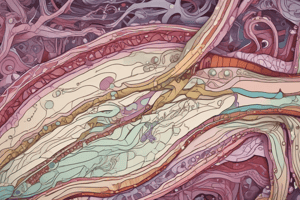Podcast
Questions and Answers
What is the study of the development of a new individual from embryo to fetus called?
What is the study of the development of a new individual from embryo to fetus called?
Which of the following microscopy techniques does not require staining to provide contrast?
Which of the following microscopy techniques does not require staining to provide contrast?
What is the study of diseased tissues called?
What is the study of diseased tissues called?
What is the term for the study of the cells and tissues of the body?
What is the term for the study of the cells and tissues of the body?
Signup and view all the answers
What is the study of the structure and function of cells called?
What is the study of the structure and function of cells called?
Signup and view all the answers
What is the term for the study of diseased cells from fluids or tissues?
What is the term for the study of diseased cells from fluids or tissues?
Signup and view all the answers
What type of microscopy is used to visualize birefringent materials?
What type of microscopy is used to visualize birefringent materials?
Signup and view all the answers
What is the resolving power of light microscopy limited by?
What is the resolving power of light microscopy limited by?
Signup and view all the answers
What is the primary advantage of dissecting stereomicroscopes?
What is the primary advantage of dissecting stereomicroscopes?
Signup and view all the answers
What type of microscopy is used to visualize fluorescent dyes?
What type of microscopy is used to visualize fluorescent dyes?
Signup and view all the answers
What is the primary disadvantage of transmission electron microscopy?
What is the primary disadvantage of transmission electron microscopy?
Signup and view all the answers
What is the primary advantage of light microscopy in terms of diagnosis?
What is the primary advantage of light microscopy in terms of diagnosis?
Signup and view all the answers
What is the main advantage of Transmission Electron Microscopy (TEM) over Scanning Electron Microscopy (SEM)?
What is the main advantage of Transmission Electron Microscopy (TEM) over Scanning Electron Microscopy (SEM)?
Signup and view all the answers
What is the purpose of fixation in preparing tissue samples for microscopy?
What is the purpose of fixation in preparing tissue samples for microscopy?
Signup and view all the answers
What is the function of Hematoxylin in the Hematoxylin-Eosin (H&E) stain?
What is the function of Hematoxylin in the Hematoxylin-Eosin (H&E) stain?
Signup and view all the answers
What is the purpose of the Periodic Acid Schiff (PAS) stain?
What is the purpose of the Periodic Acid Schiff (PAS) stain?
Signup and view all the answers
What is the main difference between Transmission Electron Microscopy (TEM) and Scanning Electron Microscopy (SEM)?
What is the main difference between Transmission Electron Microscopy (TEM) and Scanning Electron Microscopy (SEM)?
Signup and view all the answers
What is the purpose of immunohistochemistry?
What is the purpose of immunohistochemistry?
Signup and view all the answers
What is the primary focus of Microanatomy?
What is the primary focus of Microanatomy?
Signup and view all the answers
What is the study of diseased cells from fluids or tissues called?
What is the study of diseased cells from fluids or tissues called?
Signup and view all the answers
What is the term for the study of the cells and their functions?
What is the term for the study of the cells and their functions?
Signup and view all the answers
What is the primary advantage of phase contrast microscopy?
What is the primary advantage of phase contrast microscopy?
Signup and view all the answers
What is the primary function of fluorescent dyes in fluorescence microscopy?
What is the primary function of fluorescent dyes in fluorescence microscopy?
Signup and view all the answers
What is the main advantage of dissecting stereomicroscopes?
What is the main advantage of dissecting stereomicroscopes?
Signup and view all the answers
What is the main limitation of light microscopy?
What is the main limitation of light microscopy?
Signup and view all the answers
What is the purpose of polarizing filters in polarized microscopy?
What is the purpose of polarizing filters in polarized microscopy?
Signup and view all the answers
What type of microscopy is based on the interaction of electrons with tissue components?
What type of microscopy is based on the interaction of electrons with tissue components?
Signup and view all the answers
What is the main advantage of light microscopy in terms of diagnosis?
What is the main advantage of light microscopy in terms of diagnosis?
Signup and view all the answers
What is the minimum thickness of tissue sections cut by a microtome?
What is the minimum thickness of tissue sections cut by a microtome?
Signup and view all the answers
What is the purpose of liquid Xylene in tissue preparation for microscopy?
What is the purpose of liquid Xylene in tissue preparation for microscopy?
Signup and view all the answers
What is the outcome of using 10% buffered formalin as a fixative in tissue preparation?
What is the outcome of using 10% buffered formalin as a fixative in tissue preparation?
Signup and view all the answers
What is the term for the process of using antibodies labelled with fluorescent dyes or enzymes to bind to antigens in tissue samples?
What is the term for the process of using antibodies labelled with fluorescent dyes or enzymes to bind to antigens in tissue samples?
Signup and view all the answers
What is the main difference between TEM and SEM in terms of the structures they can visualize?
What is the main difference between TEM and SEM in terms of the structures they can visualize?
Signup and view all the answers
Study Notes
Microanatomy and Embryology
- Microanatomy, also known as microscopic anatomy, is the study of the cells and tissues of the body and how they integrate to form organs.
- Embryology, also known as developmental biology, is the study of the development of a new individual (development of embryo and fetus).
Liver: Gross Anatomy vs. Microanatomy
- Gross anatomy can be seen with the naked eye, whereas microanatomy requires a microscope.
Microanatomy in Clinical Veterinary Medicine
- Cytology is the study of the structure and function of cells, e.g., vaginal smear for estrus detection in canines.
- Cytopathology is the study of diseased cells from fluids or tissues, e.g., fine needle aspiration of masses (lumps and bumps).
- Histopathology is the study of diseased tissues, e.g., liver biopsy or intestinal biopsy.
Light Microscopy (LM)
- Light beam is transmitted through a tissue.
- Examples of light microscopy include:
- Bright field microscopy
- Fluorescence
- Phase-contrast
- Polarizing
- Dissecting stereomicroscope
Bright Field Microscopy
- Requires staining to provide contrast.
- Digital scanners have the same objectives to produce a digital image.
Phase Contrast Microscopy
- Observation of living, non-stained structures.
- Example: observation of sperm tail cross-section.
Transmission Electron Microscopy (TEM)
- The wavelength in the electron beam is shorter than the light beam, resulting in a 1,000-fold increase in resolution.
- Advantages:
- Great resolving power (0.16-0.18 nanometers)
- Very useful for rapid diagnosis of viruses and other microscopic organisms and storage diseases
- Disadvantages:
- Image is 2-dimensional
- Image is black and white
- Cannot be used in living objects
- Very expensive
Scanning Electron Microscopy (SEM)
- Electron beam scans the surface (3D effect).
- Only external structures, lower resolution than TEM.
- Examples: 3D structure of sperm cells and surface of uterine epithelial ciliated and secretory cells.
Electron Microscopy: TEM vs. SEM
- TEM: Transmission Electron Microscopy
- SEM: Scanning Electron Microscopy
Retrieving Tissue for Microscopic Examination
- Biopsy: sample of tissue from a living animal.
- Tissue sample/biospecimen: sample of tissue or whole organ from a dead animal.
- Images: Carolina Guerrero
- Trim to 1 cm3, place in 10 times volume of 10% formalin fixative.
Observation in Microscopy
- For light microscopy and electron microscopy, the specimen must:
- Be well preserved (retain structure and molecular composition)
- Be sufficiently thin to allow light or electron transmission
- Have enough contrast to observe details
Preservation of Tissue Structure by Fixation and Embedding
- 10% buffered formalin (hazardous) coagulates proteins in a life-like manner.
- Fixation: 10% formalin, ascending % of alcohol, liquid Xylene removes alcohol, paraffin wax solid.
Microtome
- Slices embedded tissue into thin sections.
- Sections are cut into 1-7 micrometers (μm) thin sections.
- Sections are floated on water for retrieval and staining.
Tissue Sections are Stained to Provide Contrast
- Hematoxylin – Eosin (H&E) are the most common stains used for routine evaluation.
- Hematoxylin: basic stain, stains DNA and RNA blue ('basophilic').
- Eosin: acidic stain, stains proteins pink ('eosinophilic').
Special Stains
- Masson's trichrome: stains collagen green and smooth muscle grey.
- Mallory's trichrome: stains collagen blue and nuclei red.
- Periodic Acid Schiff (PAS): localizes glycogen, glycoproteins, and mucins.
Enzyme Histoch
Studying That Suits You
Use AI to generate personalized quizzes and flashcards to suit your learning preferences.
Related Documents
Description
This quiz covers the study of microanatomy, including histology, and embryology, which is the study of the development of living organisms. It covers the structure and function of cells and tissues, and how they form organs. Questions will test your knowledge of microscopic anatomy and developmental biology.




